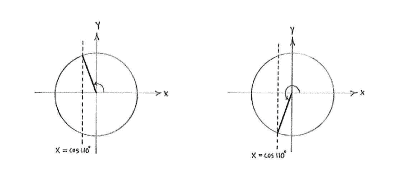Lösung 4.4:4
Aus Online Mathematik Brückenkurs 1
(Sprache und Formulierung) |
|||
| Zeile 1: | Zeile 1: | ||
| - | Wir finden zuerst die allgemeine Lösung der Gleichung | + | Wir finden zuerst die allgemeine Lösung der Gleichung und prüfen anschließend, welche der Winkel im Intervall zwischen <math>0^{\circ}</math> und <math>360^{\circ}\,</math> liegen. |
| - | Wir betrachten zuerst den Ausdruck <math>2v+10^{\circ}</math> | + | Wir betrachten zuerst den Ausdruck <math>2v+10^{\circ}</math> und erhalten die Lösung |
{{Abgesetzte Formel||<math>2v + 10^{\circ} = 110^{\circ}\,\textrm{.}</math>}} | {{Abgesetzte Formel||<math>2v + 10^{\circ} = 110^{\circ}\,\textrm{.}</math>}} | ||
| - | Es gibt noch eine Lösung im Einheitskreis | + | Es gibt noch eine weitere Lösung im Einheitskreis mit demselben Winkel zur negativen ''y''-Achse wie der Winkel <math>110^{\circ}</math> zur positiven ''y''-Achse hat, nämlich im dritten Quadranten, und zwar mit umgekehrtem Vorzeichen. Daher erhalten wir die zweite Lösung |
{{Abgesetzte Formel||<math>2v + 10^{\circ} = 270^{\circ} - 20^{\circ} = 250^{\circ}\,\textrm{.}</math>}} | {{Abgesetzte Formel||<math>2v + 10^{\circ} = 270^{\circ} - 20^{\circ} = 250^{\circ}\,\textrm{.}</math>}} | ||
| Zeile 11: | Zeile 11: | ||
[[Image:4_4_4.gif|center]] | [[Image:4_4_4.gif|center]] | ||
| - | + | Die allgemeine Lösung ist | |
| - | {{Abgesetzte Formel||<math>\left\{\begin{align} 2v + 10^{\circ} &= 110^{\circ} + n\cdot 360^{\circ}\quad\text{und}\\[5pt] 2v + 10^{\circ} &= 250^{\circ} + n\cdot 360^{\circ}\, | + | {{Abgesetzte Formel||<math>\left\{\begin{align} 2v + 10^{\circ} &= 110^{\circ} + n\cdot 360^{\circ}\quad\text{und}\\[5pt] 2v + 10^{\circ} &= 250^{\circ} + n\cdot 360^{\circ}\,.\end{align}\right.</math>}} |
| - | Lösen wir ''w'' erhalten wir | + | Lösen wir nach ''w'' auf, erhalten wir |
{{Abgesetzte Formel||<math>\left\{\begin{align} v &= 50^{\circ} + n\cdot 180^{\circ}\quad\text{und}\\[5pt] v &= 120^{\circ} + n\cdot 180^{\circ}\end{align}\right.</math>}} | {{Abgesetzte Formel||<math>\left\{\begin{align} v &= 50^{\circ} + n\cdot 180^{\circ}\quad\text{und}\\[5pt] v &= 120^{\circ} + n\cdot 180^{\circ}\end{align}\right.</math>}} | ||
| - | + | Für verschiedene ''n'' erhalten wir unter anderem die Lösungen | |
| Zeile 73: | Zeile 73: | ||
| - | Hieraus | + | Hieraus erkennen wir die Lösungen, die im Intervall von <math>0^{\circ}</math> bis <math>360^{\circ}</math> liegen: |
{{Abgesetzte Formel||<math>v = 50^{\circ},\quad v=120^{\circ },\quad v=230^{\circ}\quad\text{und}\quad v=300^{\circ}\,\textrm{.}</math>}} | {{Abgesetzte Formel||<math>v = 50^{\circ},\quad v=120^{\circ },\quad v=230^{\circ}\quad\text{und}\quad v=300^{\circ}\,\textrm{.}</math>}} | ||
Version vom 14:31, 19. Jun. 2009
Wir finden zuerst die allgemeine Lösung der Gleichung und prüfen anschließend, welche der Winkel im Intervall zwischen \displaystyle 0^{\circ} und \displaystyle 360^{\circ}\, liegen.
Wir betrachten zuerst den Ausdruck \displaystyle 2v+10^{\circ} und erhalten die Lösung
| \displaystyle 2v + 10^{\circ} = 110^{\circ}\,\textrm{.} |
Es gibt noch eine weitere Lösung im Einheitskreis mit demselben Winkel zur negativen y-Achse wie der Winkel \displaystyle 110^{\circ} zur positiven y-Achse hat, nämlich im dritten Quadranten, und zwar mit umgekehrtem Vorzeichen. Daher erhalten wir die zweite Lösung
| \displaystyle 2v + 10^{\circ} = 270^{\circ} - 20^{\circ} = 250^{\circ}\,\textrm{.} |
Die allgemeine Lösung ist
| \displaystyle \left\{\begin{align} 2v + 10^{\circ} &= 110^{\circ} + n\cdot 360^{\circ}\quad\text{und}\\[5pt] 2v + 10^{\circ} &= 250^{\circ} + n\cdot 360^{\circ}\,.\end{align}\right. |
Lösen wir nach w auf, erhalten wir
| \displaystyle \left\{\begin{align} v &= 50^{\circ} + n\cdot 180^{\circ}\quad\text{und}\\[5pt] v &= 120^{\circ} + n\cdot 180^{\circ}\end{align}\right. |
Für verschiedene n erhalten wir unter anderem die Lösungen
| \displaystyle \cdots\cdots | \displaystyle \cdots\cdots | \displaystyle \cdots\cdots | ||
| \displaystyle n=-2: | \displaystyle v = 50^{\circ} - 2\cdot 180^{\circ} = -310^{\circ} | \displaystyle v = 120^{\circ } - 2\cdot 180^{\circ} = -240^{\circ} | ||
| \displaystyle n=-1: | \displaystyle v = 50^{\circ} - 1\cdot 180^{\circ} = -130^{\circ} | \displaystyle v = 120^{\circ} - 1\cdot 180^{\circ} = -60^{\circ} | ||
| \displaystyle n=0: | \displaystyle v = 50^{\circ} + 0\cdot 180^{\circ} = 50^{\circ} | \displaystyle v = 120^{\circ} + 0\cdot 180^{\circ} = 120^{\circ} | ||
| \displaystyle n=1: | \displaystyle v = 50^{\circ} + 1\cdot 180^{\circ} = 230^{\circ} | \displaystyle v = 120^{\circ} + 1\cdot 180^{\circ} = 300^{\circ} | ||
| \displaystyle n=2: | \displaystyle v = 50^{\circ} + 2\cdot 180^{\circ} = 410^{\circ} | \displaystyle v = 120^{\circ} + 2\cdot 180^{\circ} = 480^{\circ} | ||
| \displaystyle n=3: | \displaystyle v = 50^{\circ} + 3\cdot 180^{\circ} = 590^{\circ} | \displaystyle v = 120^{\circ} + 3\cdot 180^{\circ} = 660^{\circ} | ||
| \displaystyle \cdots\cdots | \displaystyle \cdots\cdots | \displaystyle \cdots\cdots |
Hieraus erkennen wir die Lösungen, die im Intervall von \displaystyle 0^{\circ} bis \displaystyle 360^{\circ} liegen:
| \displaystyle v = 50^{\circ},\quad v=120^{\circ },\quad v=230^{\circ}\quad\text{und}\quad v=300^{\circ}\,\textrm{.} |

